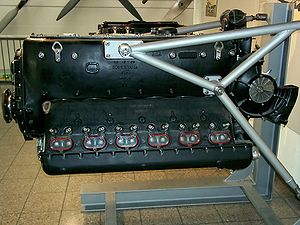- Centrifugal-type supercharger
-
For more details on this topic, see centrifugal compressor.
The centrifugal-type supercharger is an engine-driven compressor used to increase the power output of an internal-combustion engine by increasing the amount of available oxygen by compressing air that is entering the engine. This type of supercharger is practically identical in operation to a turbocharger, with the exception that instead of exhaust gases driving the compressor via a turbine, the compressor is driven from the crankshaft by a belt, gear or chain drive.
Like any centrifugal pump, the boost provided by the centrifugal supercharger increases with the square of the speed. This means that the centrifugal design provides little boost at low engine speeds, in some cases allowing air to pass back through the supercharger, such as during deceleration. On the other hand, the design is also the most efficient, besting designs like the Roots type supercharger and twin-screw type supercharger, which have the advantage of producing boost at any speed.
Many World War II piston aircraft engines, such as the Rolls-Royce Merlin and the Daimler-Benz DB 601, utilized single-speed or multi-speed centrifugal superchargers. Because high-performance aircraft engines were typically mated to constant-speed propellers and did not see a great variation in engine speeds, the poor low-rpm performance of centrifugal superchargers was not an issue. Superchargers have since fallen from use in the aviation world, replaced by turbochargers of ever-improving quality.
Due to its design and lack of low-RPM boost it is often employed on near-standard compression engines. This means that it can facilitate airflow at higher engine RPMs, when most motors tend to have poor volumetric efficiency, without substantially increasing cylinder pressures at low- to mid-RPM operation, causing knock. This principle makes this type of supercharger ideally fit for a "bolt-on" type power adder, with no modification of the pistons and/or compression ratio necessary. Since gasoline must mix with air in a fairly narrow ratio to achieve combustion, the fact that centrifugals do not add much air at low and mid-range RPM's means fuel mileage is near-stock in the cruise RPM range. They appear to be most popular with cars that have a sufficiently large engine to provide adequate acceleration from a standing start without boost, while at the same time avoiding wheelspin. Then, the engine encounters breathing limitations in the mid-RPM range, often because it may only use two valves per cylinder. Centrifugals are also popular in places where the power-adder must be removed for frequent government engine inspections, as the exhaust system is unaffected (as it would be with a turbocharger).
Compared to a turbocharger (which uses an almost identical compressor design, but instead is powered by exhaust gasses), a supercharger has the benefit of being able to reach peak boost earlier in the RPM range. A turbocharger will maintain the desired boost pressure by leaking excess gasses using a Wastegate, to keep the boost pressure at the desired level and also allow the engine to continue accelerating. A centrifugal supercharger does not have the ability to do this, so it will always make peak boost at the engine's own peak RPM (provided that the engine's peak RPM isn't beyond the peak efficiency of the compressor). The flaw in this application is that the engine will not have the same torque at lower RPM, using a centrifugal supercharger.
All supercharger types benefit from the use of an intercooler to remove heat produced during compression.
See also
Categories:- Superchargers
- Mechanical engineering
Wikimedia Foundation. 2010.

